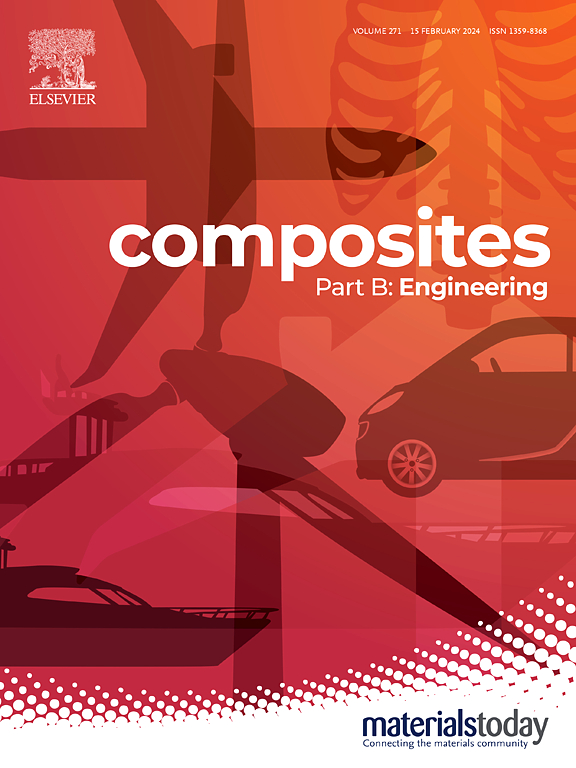Ultratough nacre-inspired soybean protein isolate/graphene nanocomposite with flame-retardant, thermal conductivity and recyclable
IF 12.7
1区 材料科学
Q1 ENGINEERING, MULTIDISCIPLINARY
引用次数: 0
Abstract
Bioplastics synthesized from soybean protein isolate (SPI) and graphite are promising alternatives but often suffer from their inability of mass production, high-cost, poor mechanical robustness, and even flammability. Herein, the scalable production of nacre-like nanocomposite by using the ball-milling spray method of graphene/SPI materials is demonstrated. The dynamic non-covalent was employed to facilitate the toughening effect of inorganic nano-fillers, while simultaneously utilizing dynamic covalent supramolecular interactions to realize plasticizer reinforcement materials. The dissipation of stress is facilitated through a combination of covalent and non-covalent interactions, thereby enhancing the interface interaction and resulting in materials with superior mechanical properties. The interfacial interaction between the SPI and the nano-reinforce confer exceptional mechanical properties to the bioplastic, achieving an excellent tensile strength 11.01 ± 0.81 MPa and fracture toughness14.52 ± 0.71 MJ/m3, which are 3.4 and 3.5 times, respectively, those of neat SPI. The recycling for highly reinforced nacre-mimetic SPI-based nanocomposites is critically enabled by the dynamic bond and improves the sustainability of bioinspired nanocomposites in cyclic economy. In addition, the SPI composite has exceptional flame retardancy, thermal conductivity, and electromagnetic shielding properties. This study provides new insights into the design of reliable and environmentally friendly biomaterials, which is significant for the development of sustainable development resources.

具有阻燃性、导热性和可回收性的超韧大豆分离蛋白/石墨烯纳米复合材料
以大豆分离蛋白(SPI)和石墨为原料合成生物塑料是一种很有前途的替代材料,但往往存在无法批量生产、成本高、机械坚固性差、甚至易燃性差的问题。本文演示了利用石墨烯/SPI材料的球磨喷涂方法可大规模生产类纳米复合材料。利用动态非共价来促进无机纳米填料的增韧效果,同时利用动态共价超分子相互作用来实现增塑剂增强材料。通过共价和非共价相互作用的结合,促进应力的消散,从而增强界面相互作用,从而使材料具有优越的力学性能。SPI与纳米增强剂的界面相互作用使生物塑料具有优异的力学性能,抗拉强度为11.01±0.81 MPa,断裂韧性为14.52±0.71 MJ/m3,分别是纯SPI的3.4倍和3.5倍。高增强纳米复合材料的循环利用是动态键的关键,提高了生物纳米复合材料在循环经济中的可持续性。此外,SPI复合材料具有优异的阻燃性、导热性和电磁屏蔽性能。本研究为设计可靠、环保的生物材料提供了新的思路,对可持续发展资源的开发具有重要意义。
本文章由计算机程序翻译,如有差异,请以英文原文为准。
求助全文
约1分钟内获得全文
求助全文
来源期刊

Composites Part B: Engineering
工程技术-材料科学:复合
CiteScore
24.40
自引率
11.50%
发文量
784
审稿时长
21 days
期刊介绍:
Composites Part B: Engineering is a journal that publishes impactful research of high quality on composite materials. This research is supported by fundamental mechanics and materials science and engineering approaches. The targeted research can cover a wide range of length scales, ranging from nano to micro and meso, and even to the full product and structure level. The journal specifically focuses on engineering applications that involve high performance composites. These applications can range from low volume and high cost to high volume and low cost composite development.
The main goal of the journal is to provide a platform for the prompt publication of original and high quality research. The emphasis is on design, development, modeling, validation, and manufacturing of engineering details and concepts. The journal welcomes both basic research papers and proposals for review articles. Authors are encouraged to address challenges across various application areas. These areas include, but are not limited to, aerospace, automotive, and other surface transportation. The journal also covers energy-related applications, with a focus on renewable energy. Other application areas include infrastructure, off-shore and maritime projects, health care technology, and recreational products.
 求助内容:
求助内容: 应助结果提醒方式:
应助结果提醒方式:


